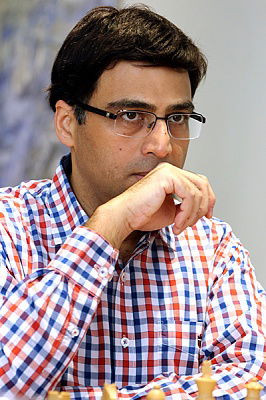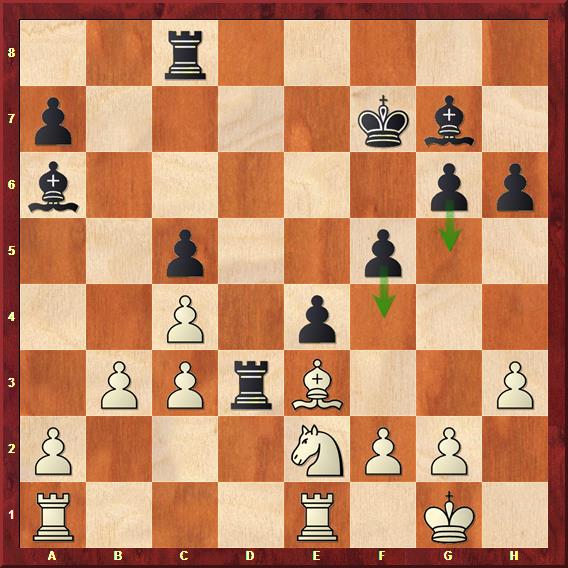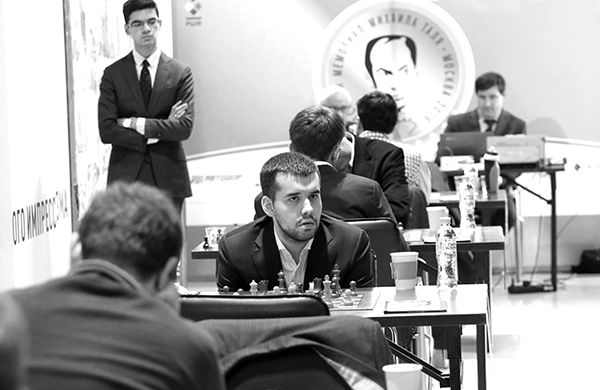Tal Memorial 05: Anand roars back to business
Gelfand had been struggling in the tournament until the fourth round, but things soon got worse for him as Vishy invaded the position of the 2012 world title challenger. In a Sicilian Rossolimo, Anand chose to aim for an opposite coloured bishop ending so that he could exploit his opponent's weak dark-squared complex on the kingside! The game is instructive in itself, but we will add value to your time. In this article, we have a game analyzed by Viswanathan Anand, additionally supplemented by the analysis of IM Sagar Shah. Enjoy the report and learn from the 5-time-world Champion!
Tal Memorial 05: Anand roars back to business
In the fourth round, Anand took on Vladimir Kramnik, the 2008 challenger to his world title, with black and was squashed. In the fifth round, Anand had white, and this time, he took on the 2012 title challenger to his crown, Boris Gelfand. Anand had slumped to 50% thanks to the loss to Kramnik. But Gelfand was having a horrible tournament with only 0.5/4! He was obviously eager to do some damage control with the black pieces. Anand opened with the king's pawn, and Gelfand chose to defend with the Sicilian Rossolimo.

Vishy Anand admitted after the game that he had not been following the Rossolimo much and was surprised to discover that the top practitioners have made theoretical advancements in this opening. "This particular line is all the rage now. 6...Nh6 is just exploding. To be honest, I had not been following the Rossolimo much but I noticed that Inarkiev played this against Gelfand. I was amazed that this had been bubbling underneath and it is hot now," Anand said after the game.

In the Gelfand-Inarkiev match that was held in July 2016, this position appeared twice and Inarkiev had chosen to play 15.Nb3. Gelfand drew one game and won the other. Anand obviously reached this position in his preparation and chose to play the machine's choice 15.Ne4. Anand commented,"The whole idea is to get opposite coloured bishops. So I exchange everything and try to get that ending."


Why would Anand be excited about going into an opposite coloured bishop ending? The reason is simple -- the colour complex. Why ask us? Let Viswanathan Anand himself explain to you what he was thinking and calculating during the game.
Anand-Gelfand (Analysis by Viswanathan Anand)
[Site "Moscow"]
[Date "2016.10.01"]
[Round "?"]
[White "Anand, Viswanathan"]
[Black "Gelfand, Boris"]
[Result "1-0"]
[ECO "B31"]
[WhiteElo "2776"]
[BlackElo "2743"]
[Annotator "Viswanathan Anand"]
[PlyCount "116"]
[EventDate "2016.??.??"]
[SourceDate "2003.06.08"]
particular line is all the rage now. ...Nh6 is just exploding. To be honest, I
had not been following the Rossolimo much but I noticed that Inarkiev played
this against Gelfand. I was amazed that this had been bubbling underneath and
it is hot now.} 7. c3 O-O 8. h3 d5 9. d3 c4 10. dxc4 dxe4 11. Qxd8 Rxd8 12.
Rxe4 e5 13. Re1 f6 14. Nbd2 Nf7 {I decided to go for this endgame. The only
difference is that we had prepared, instead of 15.Nb3 as in the
Inarkiev-Gelfand match,} 15. Ne4 {this move.} f5 16. Neg5 {The whole idea is
to get opposite coloured bishops.} e4 17. Nxf7 {So I exchange everything and
try to get that ending.} Kxf7 18. Bg5 Rd3 19. Nd4 Ba6 {to the extent of playing
} 20. b3 c5 ({Basically, what I mean is} 20... Bxd4 21. cxd4 Rxd4 22. Rad1 $18
{because Black is missing all the dark squares here and White can even bring
his king up the board and so on.}) {Of couse, he didn't give me the dark
squared bishop.} 21. Ne2 h6 22. Be3 Rc8 {Here, I have to play} 23. h4 $1 {
because otherwise, he can play ...g5, and ...f4 and get compensation for his
dark squares.} Bf6 ({We were discussing} 23... Bb7 {to stop white's knight
establishing itself on d5.}) 24. Nf4 Rdd8 25. Nd5 Bxh4 {It is very important
that I bring his bishop to h4 before I take} 26. Bxh6 Bb7 27. g3 Bf6 ({Now, if
he takes} 27... Bxd5 {Then I get the opposite coloured bishops that I want.}
28. gxh4 (28. cxd5 Bf6 {maybe I can sac the exchange and try this as well, but
that's speculative.}) 28... Be6 {Basically, the idea is to use the queenside
pawn structure as a wall against the black bishop.} 29. Rad1 {Now the thing to
remember is that if he goes} Rd3 30. Rxd3 exd3 31. Bg5 {I just take away the
d8 square and he wil lose the d3 pawn for nothing. If he tries with ...Rc6, I
will just play Bf4, f3, and win the bishop and pawn ending.}) 28. Nxf6 Kxf6 29.
Be3 {Anyway I get the wall} Rd3 30. Kf1 {Why did I play Kf1?} ({Because
suddenly I wasn't sure about} 30. Rac1 Rh8 31. Kf1 {looks winning, but
surprisingly} Rxe3 32. fxe3 (32. Rxe3 Rh1+ $19) 32... Rh2 {It is difficult to
get back the second rank and Black has some counterplay with Kg5, Kg4, etc.
Somwhere, his counterplay can get out of hand. So I thought it'll be
irresponsible to allow that.}) 30... g5 {But here it is not that trivial
because he is threatening to generate counterplay..} 31. Ke2 Rxc3 32. Rac1 {
perhaps this is not ideal.} ({I could have tried} 32. Kd2 Rd3+ {to put it on c2
} 33. Kc2 {The point is that now that I am secure on e3, I can go to the
h-file. With two rooks he cannot stop me from entering. With one rook it is
possible to stop it with ...Kg6, and that is what he did in the game.}) 32...
Rxc1 33. Rxc1 Rd8 ({What I am threatening is Rh1, and when he stops it with ...
Kg6, I can go Rd1, and things should break down. There is this alternative}
33... Kg6 34. Rd1 Kh5 35. Rd7 Bc6 {Before he can play ...Kg4 and ...f4, I
hammer it,} 36. Rg7 {so, it is difficult to execute this plan. The rook will
loop around all over the place and it is difficult for his two pieces to
control it.}) 34. Bxc5 {I don't see how to make progress without this. Now I
find myself in a situation where I can't really enter...} f4 (34... Kg6 35. Be3
{and then go b4, b5. Already I can consider Rc2, d2 and the endgame.} (35. Bxa7
Ra8)) 35. gxf4 gxf4 36. Bxa7 e3 {I decided to go for this endgame with four
pawns for the piece.} 37. Bxe3 ({It is important not to get distracted with}
37. fxe3 f3+ {And he can go Be4 which is just annoying as I will always be
fighting against the f pawn. So, I decided that best is to just play the text.}
) 37... fxe3 38. Kxe3 Bc8 {I would most likely lose the f-pawn somewhere along
the way, but the advantage for white is that in the meantime, if I build up
the pawn strucure, let's say a6-c4, then I can just ditch the f-pawn.} 39. Rc2
Bf5 40. Rd2 Ra8 41. Kd4 Ke6 (41... Ra3 {is a good sameple line to understand
this.} 42. Kc3 (42. Rb2 {I guess I don't want to do this, because he may use
this chance to slide over to the queenside.}) 42... Bb1 {He is not threatening
to take becauase of Kb2, but at the same time I cannot make progress. Then I
found} 43. Kb4 Rxa2 44. Rxa2 Bxa2 45. Kc3 Bb1 46. Kd4 Ke6 47. b4 Kd6 48. b5 Bf5
49. f4 {he will never be able to stop both pawns. I was gonna double check
this, but my hunch is this is just winning.}) 42. Kc3 Ke5 43. a4 Be4 {I think
the important move in the ending was} 44. Kb4 (44. Re2 {was my original idea
threatening f3..} Rf8 45. a5 Rf3+ 46. Kb4 Kd4 47. Rd2+ Bd3 48. a6 Rf8 {I was
not sure about this.}) 44... Rb8+ {but here my rook is perfectly placed on d2.}
45. Ka3 {Now there is no going back for him. If he goes Ra8, I go b4-b5, and
if he goes Rc8, I go a5. I guess it is just slowly winning.} Rf8 46. a5 Rf3 47.
Kb4 Bb7 48. Rd8 Rxf2 49. Kc5 Rf6 50. Re8+ Kf4 51. b4 Rc6+ 52. Kd4 Rd6+ 53. Kc5
Rc6+ 54. Kb5 Rf6 55. Re7 Ba6+ 56. Kc5 Rf5+ 57. Kd4 Kf3 58. b5 Bxb5 {His king
is cut off so far that I will get a Lucena anyway.} (58... Bxb5 59. cxb5 Rxb5
60. a6 Ra5 61. a7 Kf4 $18) 1-0

For good measure, we also have a deeply annotated game by our very own IM Sagar Shah:
Anand-Gelfand (Analysis by IM Sagar Shah)
[Site "Moscow"]
[Date "2016.10.01"]
[Round "?"]
[White "Anand, Viswanathan"]
[Black "Gelfand, Boris"]
[Result "1-0"]
[WhiteElo "2776"]
[BlackElo "2743"]
[Annotator "Sagar Shah"]
[PlyCount "115"]
[EventDate "2016.??.??"]
[SourceDate "2003.06.08"]
obvious that he wasn't in the best of spirits. However, his opponent Boris
Gelfand's situation was even worse. The Israeli had lost three games out of
four and was on 0.5/4.} 1. e4 {0} c5 {0 Uncompromising play by Boris. He could
have settled for something solid, but as always he stays true to his Sicilian.}
2. Nf3 {0} Nc6 {0} 3. Bb5 {0 Like in the 2012 World Championship Match, Anand
doesn't want to test Gelfand's Sveshnikov. Hence, he goes for the Rossolimo.}
g6 {0} 4. Bxc6 {0} bxc6 {0 This is much more combative than the other
recapture.} (4... dxc6 {leads to a more positional game.}) 5. O-O {17} Bg7 {0}
6. Re1 {19} (6. c3 Nf6 7. Re1 O-O {allows Black to castle, although this too
is possible.}) 6... Nh6 {0} (6... Nf6 7. e5 Nd5 8. c4 {Has scored very well
for White in the past.}) 7. c3 {32} O-O {0} 8. h3 {13} (8. d4 cxd4 9. cxd4 d5
10. e5 f6 {was the game between Gelfand and Inarkiev in their recently
concluded match. This was the first rapid game.}) 8... d5 {50} 9. d3 {83 White
is playing in a slow fashion and it seems like Black should easily equalize.
However, as long as the pawn remains on e4, the knight on h6 is pretty passive
and Black has problems to do something useful. Bear in mind that White has the
positional ideas of playing Be3 or Nd2-b3, attacking the c5 pawn.} c4 {29} 10.
dxc4 {54} dxe4 {36} 11. Qxd8 {7} Rxd8 {3} 12. Rxe4 {12} e5 {59} 13. Re1 {53} f6
{40} 14. Nbd2 {66} Nf7 {105} 15. Ne4 $146 {10 This is Anand's novelty over
Gelfand's two games against Inarkiev which reached this position. White just
wants to play b3 and get his bishop to a3 and control the c5 square.} ({
This was played in the long time control game.} 15. Nb3 a5 16. Be3 a4 17. Bb6
Re8 18. Nc5 g5 ({This was the rapid game that Gelfand won.} 18... Bf5 19. Nh4
Bc8 20. Rad1 f5 21. Nf3 e4 22. Nd4 Ne5 23. b3 axb3 24. axb3 Bf8 25. Ra1 Rxa1
26. Rxa1 Bh6 27. Bc7 Nd7 28. Nxd7 Bxd7 29. b4 e3 30. f4 Bg7 31. Kf1 e2+ 32. Kf2
Be6 33. Nxe6 Bxc3 34. Be5 Bxa1 35. Nc7 Re7 36. b5 Bxe5 37. fxe5 Rxc7 38. b6 Re7
{0-1 (38) Inarkiev,E (2730)-Gelfand,B (2734) Magas 2016}) 19. b3 g4 20. hxg4
axb3 21. axb3 Bxg4 22. Nh4 f5 23. Rxa8 Rxa8 24. Nd7 f4 25. Nc5 Rb8 26. Bc7 Rc8
27. Ba5 Ra8 28. Bb4 Ng5 29. Nd3 e4 30. Nxf4 Be5 31. g3 Kf7 32. Rc1 Ra2 33. Bc5
Bxf4 34. gxf4 Nh3+ 35. Kh2 Nxf4 36. Re1 Nd3 37. Rxe4 Nxc5 38. Rf4+ Ke6 39. b4
Na4 40. Re4+ Kf6 41. Rxg4 Rxf2+ 42. Kg3 Rc2 43. Rf4+ Ke6 44. Nf3 Rxc3 45. Re4+
Kf6 46. Rf4+ Ke6 47. Kg4 Nb2 48. Re4+ Kf6 49. Rf4+ Ke6 50. Ng5+ Kd7 51. Rf7+
Kc8 52. c5 Nd3 53. Rxh7 Rc4+ 54. Kf5 Rxb4 55. Ne6 Kb8 56. Kf6 Rc4 57. Rh5 Nf4
58. Rh8+ Kb7 59. Nd8+ Ka6 60. Nxc6 Rxc5 61. Nb8+ Kb5 62. Nd7 Rc6+ 63. Kf5 Nd5
64. Rb8+ Nb6 65. Rxb6+ Rxb6 66. Nxb6 Kxb6 67. Ke4 {1/2-1/2 (67) Inarkiev,E
(2730)-Gelfand,B (2734) Magas 2016}) 15... f5 {634 Gelfand took ten minutes to
execute this move which clearly showed that this move was new for him.} 16.
Neg5 {80} (16. Nc5 Bf8 $11) 16... e4 {1038} 17. Nxf7 {725} Kxf7 {33} 18. Bg5 {
9 Anand is still in his prep, and blitzing out the moves.} Rd3 {970} 19. Nd4 {
35} Ba6 {53} (19... Bxd4 20. cxd4 Rxd4 21. Rad1 {Although material is equal
and we have opposite coloured bishops on the board, White is better thanks to
his lead in developement. An illustrative line could go something like} Rxd1
22. Rxd1 Be6 23. b3 a5 24. Rd6 Ra6 25. Rd8 $36) 20. b3 {748} (20. Nxc6 Bxc4 21.
Rad1 $14) 20... c5 {977} (20... Rxc3 21. Nxc6 $16) 21. Ne2 {20 It seems like
Black should have enough compensation for the pawn here in the form of more
active pieces and the bishop pair. However, White's moves are very natural. He
intends to challenge the rook on the d-file and also attack the c5 pawn with
Be3.} h6 {136} 22. Be3 {80} Rc8 {9} 23. h4 $1 {609 Played after 10 minutes of
thought. Anand clearly realized that he needed to be aware of what Black's
idea is in the position. Clearly Gelfand wanted to mobilise his kingside
majority with g5 and f4. Hence, the prophylactic h4!} (23. Rad1 g5 {And Black
is getting loads of counterplay with his kingside majority.}) 23... Bf6 {1105}
24. Nf4 $6 {297} (24. Bxh6 $1 Bxh4 25. Nf4 Rd2 26. Nh3 Rd7 27. Rad1 $16) 24...
Rdd8 {83} 25. Nd5 {29} Bxh4 $6 {286 Gelfand misses his opportunity. He could
have equalized the game by temporarily sacrificing an exchange.} (25... Rxd5 $1
26. cxd5 Bxc3 27. Bxh6 Bd3 $11) 26. Bxh6 {29} Bb7 {136} 27. g3 {347} Bf6 {129}
(27... Bxd5 28. gxh4 $16 (28. cxd5 $2 Bf6 $17)) 28. Nxf6 $1 {40 Anand is a
pawn up and is not afraid of going into an opposite coloured bishop endgame.
He clearly realizes that his queenside superiority gives him an advantage.}
Kxf6 {5} 29. Be3 {27} Rd3 {100} 30. Kf1 {1014} g5 {473} (30... Rxc3 31. Rad1
$16) 31. Ke2 {94} Rxc3 {71} 32. Rac1 {410} Rxc1 {60} (32... Rd3 33. Rh1 $16)
33. Rxc1 {56} Rd8 {45 Gelfand realizes that he has to do something drastic in
order to stop White from simply strengthening his position. He gives up the c5
pawn in the hope that he would be able to create sufficient play with the move
f5-f4. Unfortunately for him Anand had seen further.} 34. Bxc5 $1 {271} f4 {125
} 35. gxf4 {89} gxf4 {9} 36. Bxa7 $1 {11} e3 $5 {215 Gelfand gives up another
pawn. His hope is that White will take on e3 with his pawn and then he can
push ahead with f3. His rook, bishop and pawn will create some play.} (36...
f3+ 37. Ke1 $18) 37. Bxe3 $1 {111 Although the computer doesn't like this move
I think practically it is a good solution. Defending with a bishop against
four pawns is no easy task.} (37. fxe3 f3+ 38. Ke1 Kf5 {Although White is
three pawns up, he needs to be careful. The f3 pawn cannot be taken lightly.
Objectively White should be better. But what Anand did in the game was more
practical.}) 37... fxe3 {14} 38. Kxe3 {4} Bc8 {56} 39. Rc2 {56} Bf5 {45} 40.
Rd2 {0} Ra8 {0} (40... Rxd2 41. Kxd2 $18 {is completely lost.}) 41. Kd4 {48}
Ke6 {432} 42. Kc3 {44} Ke5 {68} 43. a4 {44} Be4 {68} 44. Kb4 {711} Rb8+ {162}
45. Ka3 {47} Rf8 {5} 46. a5 {39 You can see how easy it is to play as White.
He just has to keep pushing his pawns!} Rf3 {41} 47. Kb4 {162} Bb7 {58} 48. Rd8
{299} Rxf2 {228} 49. Kc5 {18 White gave back one pawn, but now his rook, king
and three pawns are very active. All in all this is already a lost position
for Black.} Rf6 {71} 50. Re8+ {209} Kf4 {238} 51. b4 {107} Rc6+ {51} 52. Kd4 {
27} Rd6+ {13} 53. Kc5 {152} Rc6+ {24} 54. Kb5 {14} Rf6 {155} 55. Re7 {37} Ba6+
{69} 56. Kc5 {14} Rf5+ {4} 57. Kd4 {7} Kf3 {35} 58. b5 {13 The pawns are
queening and Gelfand resigned. An excellent game by Anand and a clear case of
Gelfand being completely off colour.} 1-0


